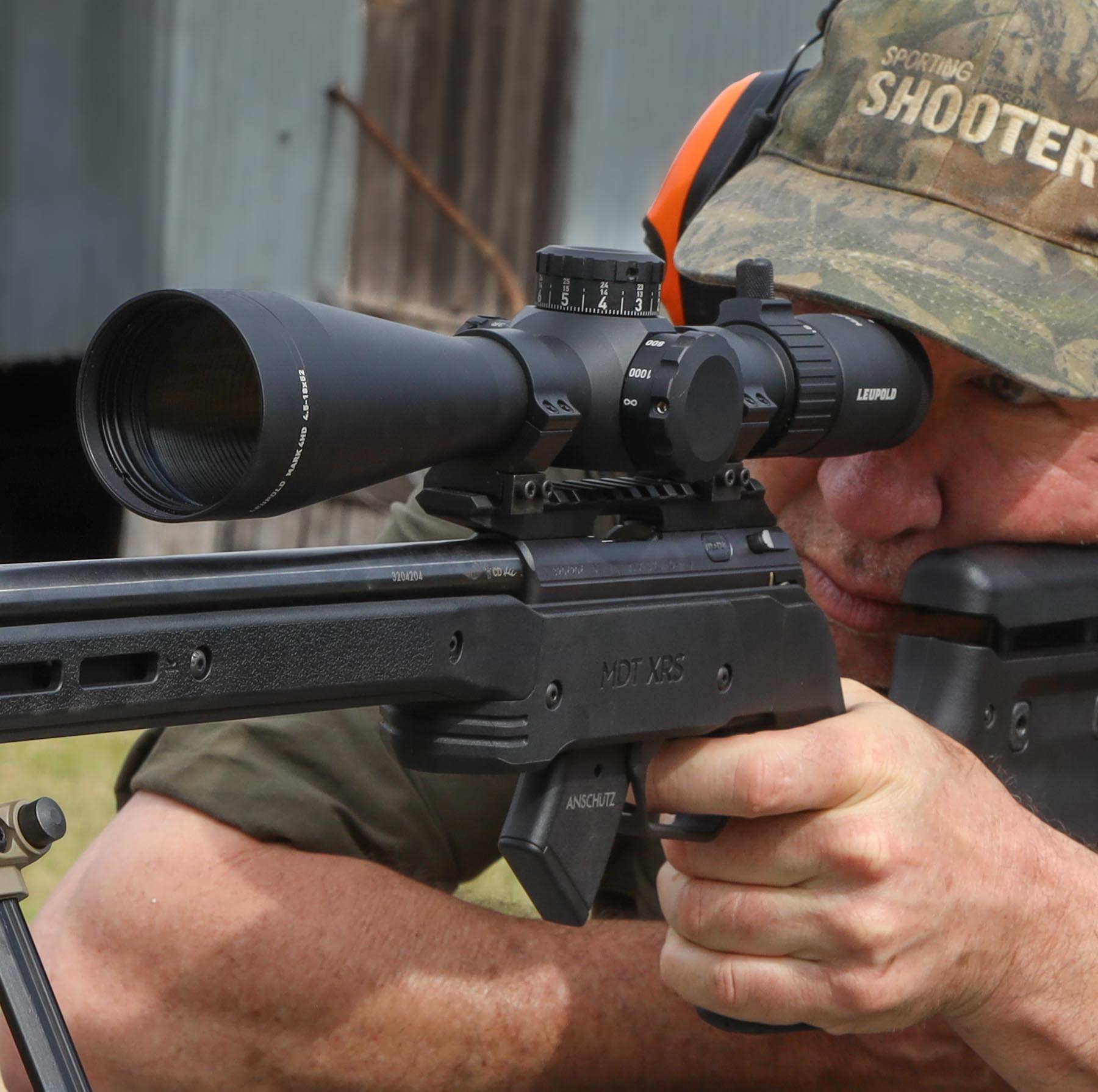Blog/Review: Weatherby Model 307 Range XP

Review: Weatherby Model 307 Range XP
Last updated: 11 Dec, 2024 | Author: Mick Matheson
The Model 307 may be nothing like what you’d expect from Weatherby but the Range XP version demonstrates unequivocally that this most traditional of US gunmakers can step outside its box to take on a new concept and get it right first time.
True, the 307 is built on the Remington 700 platform and is therefore not a new concept as such, but it’s all new to a company that has been building the faithful Mark V for 67 years, the simpler Vanguard for 54 years, some shotguns and not much else.

Except for the bolt-action design, this is a massive departure for Weatherby, precipitated by its move in 2018 to Sheridan, Wyoming (area code 307 if you’re wondering) and the enlistment of new blood. CEO Adam Weatherby, grandson of founder Roy, brought in Luke Thorkildsen as product development manager, and Luke brought the idea for what he calls a “more open-source action”.
Five years later the 307 made its debut.
The action’s critical measurements inside and out are pure Remington 700, varying only in the shape of the ejection port and in other aesthetics. The bedding surfaces and scope-mounting surfaces are the same; the gas ports the same; locking lugs; bolt guide rail; trigger mounts; the lot are all compatible with aftermarket Model 700 items. The 307 sandwiches a recoil lug between the barrel and receiver as the Model 700 does.
The bolt, too, could almost be out of Remington’s tooling bar some details like the deep spiral fluting and different profiles of the cocking piece, shroud and handle.

But Weatherby incorporated some important improvements on the 700 design. The receiver hosts the bolt release lever in its left size, as most rifles have them, rather than under the front of the trigger blade like most 700s. It’s quicker and easier to use.
So is the bolt’s takedown: remove the bolt, push down on the shroud (it does require a little strength), pull out the handle and the firing pin assembly is released. Makes cleaning and greasing that much easier.
Arguably the most significant upgrade, though, is Weatherby’s installation of an M16-type extractor. It’s a 32mm-long claw pivoting about 20mm back with a strong spring to operate it. It should be ultra-reliable.
Weatherby has installed a TriggerTech Field trigger unit, which is the same as the Model 700 version except without the bolt release button. In a rifle full of nice features, this is one of the nicest. TriggerTech’s design is unique, a slightly complex but bulletproof system with linkages and rollers that gets as close to having no creep as it’s possible to go, with virtually no over-travel and minimal trigger movement.

The single-stage trigger is externally adjustable down to 1.1kg (2.5lb) and has the most consistent let-off you’ll ever experience. A side effect of the design is that the weight of the firing-pin spring has an impact on trigger pull weight but it appears either Weatherby or TriggerTech, or maybe both together, matched them for the 307 because the measured minimum weight on the test rifle’s trigger was bang on the claimed minimum.
All of that is conducive to excellent accuracy. The trigger also feels fantastic as you touch off the shot.
You could improve it, though, because the Field is the heaviest TriggerTech option. As you step up the TriggerTech line you get lighter pull weights and, by all accounts, even sweeter let-off feel. And while it’s hard to beat a TriggerTech there are also lots of other M700-type options.
The safety is part of the trigger assembly and, like a Model 700, it’s a two-position unit. It blocks both sear and trigger and does not lock the bolt down.

The bottom metal, or polymer, is from Magpul, another highly rated aftermarket manufacturer. It is, naturally, M700 compatible. The magazine release is an ambidextrous paddle in front of the trigger guard; push to release the five-round Magpul box mag.
The single-stack magazine is very tough polymer except for a coiled wire spring providing good tension to the slick-surfaced plastic follower.
The barrel comes from the same stock as the Mark V’s. It has deep spiral fluting like the bolt, flowing from about 9cm ahead of the receiver almost to the 16.5mm muzzle. The muzzle is threaded ½-28 and fitted with a tidy little Accubrake muzzle brake, regardless of calibre. The brake works nicely on the .243 to return your sight picture as quickly as possible after a shot but if you don’t like the muzzle blast that results you can always remove it and fit the cap supplied with the rifle.
The barrel on the test rifle did not foul. On arrival it had a hint of copper and carbon in the rifling from the factory test shots but that vanished after I’d fired a few shots and never returned. After 200 rounds with only a bore snake through it after every 5-10 shots, the bore was almost pristine.

The Range XP’s composite polymer stock has a very similar profile to the Peak 44 Bastion carbon-fibre stocks fitted to a few of the Mark V models. Its 1.1kg weight contributes a third of the bare 307’s 3.3kg. It has internal bracing to add strength but there is no extra bedding. This doesn’t stop the Range XP from shooting very accurately but it’s possibly the first place you might find even better accuracy.
The stock allows the barrel to float for its full length. The clearance is tight and consistent all the way, a pleasing look that implies better quality and attention to detail than the big and often uneven gaps on many rifles.
It has a steep pistol grip for shooting from the prone position or on a bench. The fore-end has the familiar chiselled tip and flat base that’s almost a Weatherby trademark. It is ambidextrous in that the profile is the same left and right. All grip surfaces have a random stippling moulded in, and the rest of the stock is finished the same only more sparsely.
The comb has an adjustable cheekpiece which comes up through three settings and is secured by four screws so it’s not quickly adjustable. I suppose that unless you’re sharing the rifle in time-critical situations, there’s no need for quick adjustment, and Weatherby’s system is never going to be accidentally dislodged at a crucial moment.

You can add spacers to increase length of pull from the minimum 345mm; one 6mm spacer is supplied standard. The recoil pad is soft and deep, working with the brake to make the .243 a pussycat.
Two sling swivels, plus a third for bipod mounting, are set into the stock. We had a Magpul bipod clamped to the front stud — this is a neat bipod that’s light but very strong, with adjustable tension on its cant movement and legs that extended it incrementally from 18cm to 26cm above ground height.
Weatherby has endowed its .243 barrel with a quick 1:7.5” twist, which should stabilise the heaviest bullets available for the calibre. It’s much faster than the standard 1:10 and a bit faster even than the 1:8 rate that’s now considered quick in a .243. With 1:10 twist in a .243, I’ve rarely been happy with projectiles over 90gn but with 1:7.5 you could go all the way to 115gn with confidence. At least, logic says so but I didn’t have the bullets to try.
Long-range shooters who want to experiment with those long, sleek, high-BC bullets can seat the projectiles out to an overall cartridge length of just shy of 73mm and still fit them in the magazine; you’ll likely have to get the chamber long-throated to accomodate the longer rounds, though.

In accuracy testing, the Weatherby shot sub-MOA five-shot groups with six of the factory loads tested, and averaged sub-MOA with four of them. The full results are summarised in the table. I shot five-shot groups all the way and saw no evidence that exceeding three shots opened up the group size at all. Maybe Weatherby is under-selling its rifle by offering a sub-MOA guarantee for just three-shot groups.
Interestingly, points of impact varied little between most different ammunition types and some were almost identical: the six most accurate loads shot groups that overlapped.

Shooting a choice of many .243 loads, knowing your trajectory and using an excellent long-range scope like the ZeroTech Trace ADV on the test rifle, the Range XP would be hard to beat for varmints, predators and medium game over hundreds of metres.
Several Weatherby fans told me they were disappointed by the 307. They were all Mark V owners and Mauser 98 admirers who can’t say “Winchester Model 70” without cursing 1964 in the same breath. They will never buy a Model 307 but Weatherby is fine with that because it is successfully wooing an entirely new group of customers with this rifle.

The 307 might be a Remington 700 clone but that’s the point: it is exactly what Weatherby wanted it to be, for good reason. Weatherby has gone down the path of ultimate potential with the 307, a rifle that perfectly complements — as opposed to competing with — the entry-level Vanguard and prestige Mark V.
As if to underline that, Weatherby will (soon) sell you a 307 action on its own so you can build an entire custom rifle around it. Not convinced the Range XP is good enough for you? A 307 action is your shucking knife and the 700 aftermarket world is your oyster.
Another thing: Weatherby makes the 307 in its Wyoming factory. Weatherby has not made its own rifles since it outsourced Mark V manufacturing to Germany way back in 1958. Making its own rifle in-house is not just a big deal for Weatherby, it’s a major commitment to its new product.
The 307 Range XP is a quality hunting and target rifle, good for sub-MOA with various factory ammo, and it’s a pleasure to shoot. It wears some very good quality components including that pretty fluted Weatherby Mark V-based barrel and the TriggerTech trigger. You couldn’t build it yourself for the asking price and so, with its performance in mind, it’s a great buy.

SPECIFICATIONS
- Manufacturer: Weatherby, Wyoming USA
- Type: Turn-bolt repeater
- Calibres: .240 Wby Mag, .243 Win (tested), .257 Wby Mag,6.5 CM, 6.5 Wby RPM, .270 Win, .280 Ackley Imp, 7mm PRC,7mm Rem Mag, .308 Win, .30-06, .300 Win Mag
- Barrel: 56cm (22”) plus 5cm (2”) Accubrake; 1:7.5” twist; spiral fluted; muzzle threaded ½-28
- Finish: Graphite Black Cerakote
- Magazine: Magpul removable box, 5 rounds
- Trigger: TriggerTech Field, adjustable 1.1-2.3kg (2.5-5lb)
- Safety: 2 stage, blocks trigger and sear
- Sights: None; drilled and tapped for scope mounting
- Stock: Composite polymer, olive green; adjustable comb
- Length: 105cm (41.5”)
- Weight: 3.3kg (7.3lb) bare
- Price: $2965
- Distributor: TSA Outdoors
Recent Blogs

Big Tech is Silencing Shooters & Hunters – Here’s What We Can Do About It
Last updated: 03 Feb, 2025
By: Gun Traders Australia

Review: Pulsar Axion 2 LRF XQ35 thermal monocular
Last updated: 17 Dec, 2024
By: Gun Traders Australia


